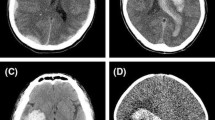Abstract
Introduction
Intracranial hemorrhage due to head trauma in patients with hemophilia is a major cause of mortality and morbidity. The incidence of central nervous system bleeding in these patients is between 3 and 8%. In this study, we shared our experience on the treatment and follow-up of seven pediatric patients with hemophilia A who had intracranial bleeding due to trauma.
Materials and methods
Between 2010 and 2019, the clinical and radiological findings of seven pediatric patients with hemophilia A with intracranial hemorrhage were retrospectively evaluated in our clinic. One patient underwent operation owing to intracranial hemorrhage, and the other six underwent conservative treatment. Hemoglobin, aPTT (activated partial thromboplastin time), and factor VIII levels were measured at regular intervals. For intracranial hemorrhage follow-up, regular computed tomography (CT) was performed.
Results
All patients visited the emergency department with initial neurological complaints. Further, two of the seven patients died, one was treated with sequelae (cerebral palsy), and the other four were treated without sequelae.
Conclusions
Early diagnosis and treatment of intracranial hemorrhage is very important in patients with bleeding disorders. Factor VIII replacement should be performed in such patients prior to radiological examinations and consultations. The main objective should be to bring factor VIII levels to normal limits during their treatment and follow-up.





Similar content being viewed by others
References
Srivastava A, Brewer AK, Mauser-Bunschoten EP, Key NS, Kitchen S, Llinas A, Ludlam CA, Mahlangu JN, Mulder K, Poon MC, Street A (2013) Guidelines for the management of hemophilia. Haemophilia 19:e1–e47
Cho JY, Lee WS, Park YS, Lee SH, Koh JS (2016) Clinical characteristics and prognostic factors in hemophiliacs with intracranial hemorrhage: a single-center, retrospective experience. Indian J Hematol Blood Transfus 32:488–493
Nagel K, Pai MK, Paes BA, Chan AK (2013) Diagnosis and treatment of intracranial hemorrhage in children with hemophilia. Blood Coagul Fibrinolysis 24:23–27
Balak N, Silav G, Kilic Y, Timur C, Elmaci I (2007) Successful surgical treatment of a hemophiliac infant with nontraumatic acute subdural hematoma. Surg Neurol 68:537–540 discussion 540
Colleti Junior J, Koga W, de Carvalho WB (2015) Spontaneous intracranial hemorrhage in children: report of a hemophilia patient who survived due to a brain cyst. Rev Bras Ter Intensiva 27:412–415
Zakaria Z, Kaliaperumal C, Crimmins D, Caird J (2018) Neurosurgical management in children with bleeding diathesis: auditing neurological outcome. 21:38
Senapati SB, Mishra SS, Dhir MK, Das S (2016) Intracerebellar haemorrage in a haemophilia child. Asian J Neurosurg 11:179–179
Hegde A, Nair R, Upadhyaya S (2016) Spontaneous intracerebral hemorrhage in hemophiliacs-a treatment dilemma. Int J Surg Case Rep 29:17–19
Hermans C, Altisent C, Batorova A, Chambost H, De Moerloose P, Karafoulidou A, Klamroth R, Richards M, White B, Dolan G (2009) Replacement therapy for invasive procedures in patients with haemophilia: literature review, European survey and recommendations. Haemophilia 15:639–658
Tabibian S, Motlagh H, Naderi M, Dorgalaleh A (2018) Intracranial hemorrhage in congenital bleeding disorders. Blood Coagul Fibrinolysis 29:1–11
Patiroglu T, Ozdemir MA, Unal E, Altuner Torun Y, Coskun A, Menku A, Mutlu FT, Karakukcu M (2011) Intracranial hemorrhage in children with congenital factor deficiencies. Childs Nerv Syst 27:1963–1966
Pavithran K, Thomas M (2002) Spontaneous resolution of subdural hematoma in haemophilia. Haematologica 87:Elt03
Grelat M, Madkouri R, Bousquet O (2016) Acute isodense subdural hematoma on computed tomography scan-diagnostic and therapeutic trap: a case report. J Med Case Rep 10:43
Majidi S, Rahim B, Gilani SI, Gilani WI, Adil MM, Qureshi AI (2016) CT evolution of hematoma and surrounding hypodensity in a cadaveric model of intracerebral hemorrhage. J Neuroimaging 26:346–350
Macellari F, Paciaroni M, Agnelli G, Caso V (2014) Neuroimaging in intracerebral hemorrhage. Stroke 45:903–908
McDowell MM, Kellner CP, Barton SM, Mikell CB, Sussman ES, Heuts SG, Connolly ES (2013) The role of advanced neuroimaging in intracerebral hemorrhage. Neurosurg Focus 34:E2
Acknowledgments
Preparation for publication of this article is partly supported by the Turkish Neurosurgical Society.
Author information
Authors and Affiliations
Corresponding author
Ethics declarations
Conflict of interest
The authors declare that they have no conflict of interest.
Additional information
Publisher’s note
Springer Nature remains neutral with regard to jurisdictional claims in published maps and institutional affiliations.
Rights and permissions
About this article
Cite this article
Aras, M., Oral, S. Management of intracranial hemorrhage in hemophilia A patients. Childs Nerv Syst 36, 2041–2046 (2020). https://doi.org/10.1007/s00381-020-04528-3
Received:
Accepted:
Published:
Issue Date:
DOI: https://doi.org/10.1007/s00381-020-04528-3




